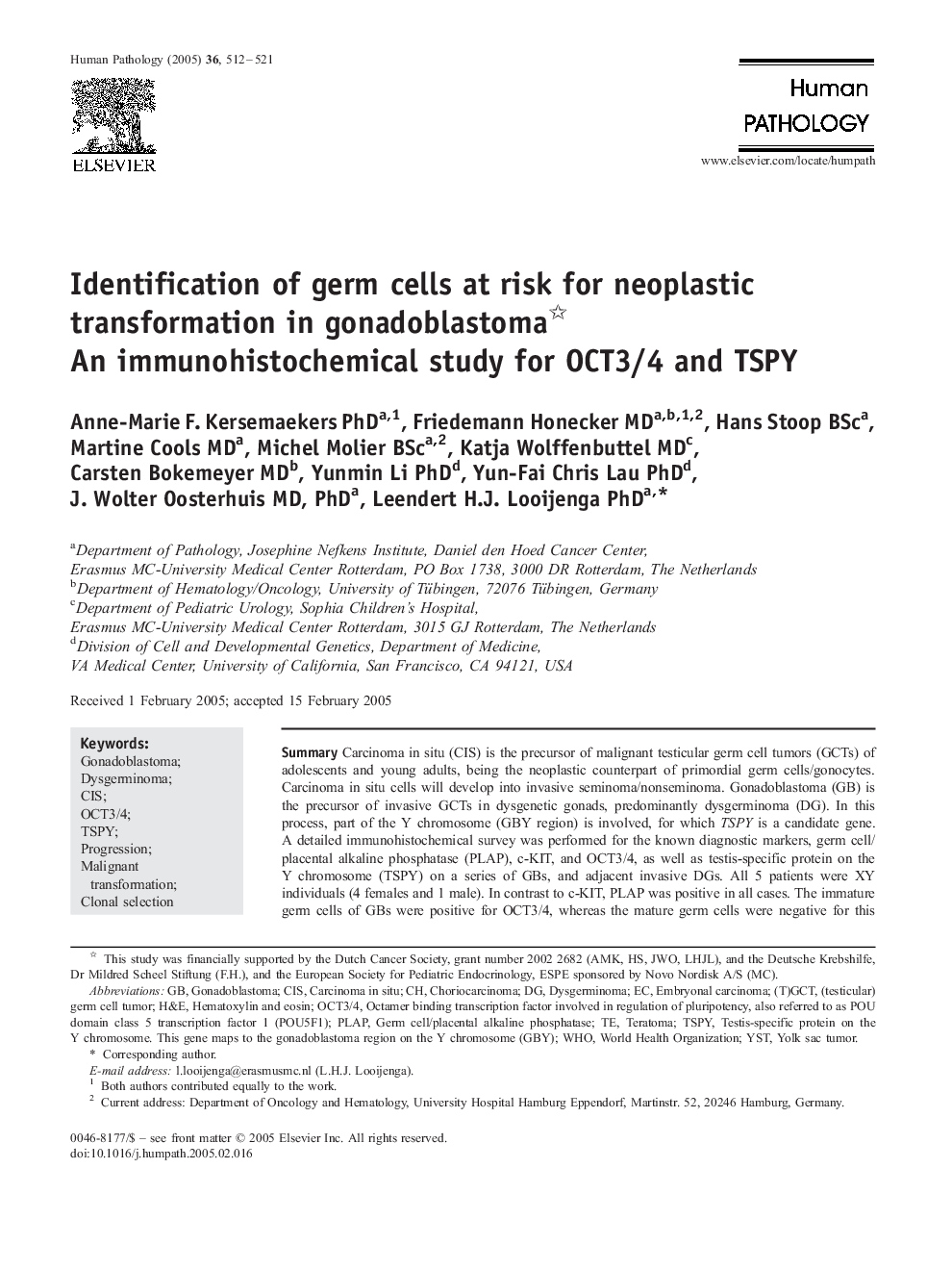| کد مقاله | کد نشریه | سال انتشار | مقاله انگلیسی | نسخه تمام متن |
|---|---|---|---|---|
| 9365412 | 1271506 | 2005 | 10 صفحه PDF | دانلود رایگان |
عنوان انگلیسی مقاله ISI
Identification of germ cells at risk for neoplastic transformation in gonadoblastoma
دانلود مقاله + سفارش ترجمه
دانلود مقاله ISI انگلیسی
رایگان برای ایرانیان
کلمات کلیدی
CISTSPYDysgerminomaYSTPLAPH&E - H & EOCT3/4 - OCT3 / 4Clonal selection - انتخاب کلونالMalignant transformation - تحول بدخیمTeratoma - تراتوم، تراتوماYolk sac tumor - تومور ساکشن ژلهWorld Health Organization - سازمان بهداشت جهانیHematoxylin and Eosin - هماتوکسیلین و ائوزینProgression - پیشرفتCarcinoma in situ - کارسینوم درجاEmbryonal carcinoma - کارسینومای EmbryonalChoriocarcinoma - کریوکارسینوماWHO - کهGonadoblastoma - گنادوبلاستوما
موضوعات مرتبط
علوم پزشکی و سلامت
پزشکی و دندانپزشکی
آسیبشناسی و فناوری پزشکی
پیش نمایش صفحه اول مقاله

چکیده انگلیسی
Carcinoma in situ (CIS) is the precursor of malignant testicular germ cell tumors (GCTs) of adolescents and young adults, being the neoplastic counterpart of primordial germ cells/gonocytes. Carcinoma in situ cells will develop into invasive seminoma/nonseminoma. Gonadoblastoma (GB) is the precursor of invasive GCTs in dysgenetic gonads, predominantly dysgerminoma (DG). In this process, part of the Y chromosome (GBY region) is involved, for which TSPY is a candidate gene. A detailed immunohistochemical survey was performed for the known diagnostic markers, germ cell/placental alkaline phosphatase (PLAP), c-KIT, and OCT3/4, as well as testis-specific protein on the Y chromosome (TSPY) on a series of GBs, and adjacent invasive DGs. All 5 patients were XY individuals (4 females and 1 male). In contrast to c-KIT, PLAP was positive in all cases. The immature germ cells of GBs were positive for OCT3/4, whereas the mature germ cells were negative for this marker, but positive for TSPY. In every GB, a minor population of germ cells positive for both markers could be identified, similar to most CIS cells and early invasive DG. On progression to an invasive tumor, TSPY can be lost, a process that is also detectable in invasive testicular GCTs compared to CIS. These results indicate that GB is a heterogeneous mix of germ cells, in which the OCT3/4-positive cells have the potential to undergo progression to an invasive tumor. These early invasive stages are initially also positive for TSPY (like CIS), supporting a positive selection mechanism. Therefore, OCT3/4 in combination with TSPY is valuable to identify malignant germ cells in dysgenetic gonads. This could allow better prediction of the risk of progression to a GCT. In addition, the data support the model that GB represents the earliest accessible developmental stage of malignant GCTs.
ناشر
Database: Elsevier - ScienceDirect (ساینس دایرکت)
Journal: Human Pathology - Volume 36, Issue 5, May 2005, Pages 512-521
Journal: Human Pathology - Volume 36, Issue 5, May 2005, Pages 512-521
نویسندگان
Anne-Marie F. PhD, Friedemann MD, Hans BSc, Martine MD, Michel BSc, Katja MD, Carsten MD, Yunmin PhD, Yun-Fai Chris PhD, J. Wolter MD, PhD, Leendert H.J. PhD,